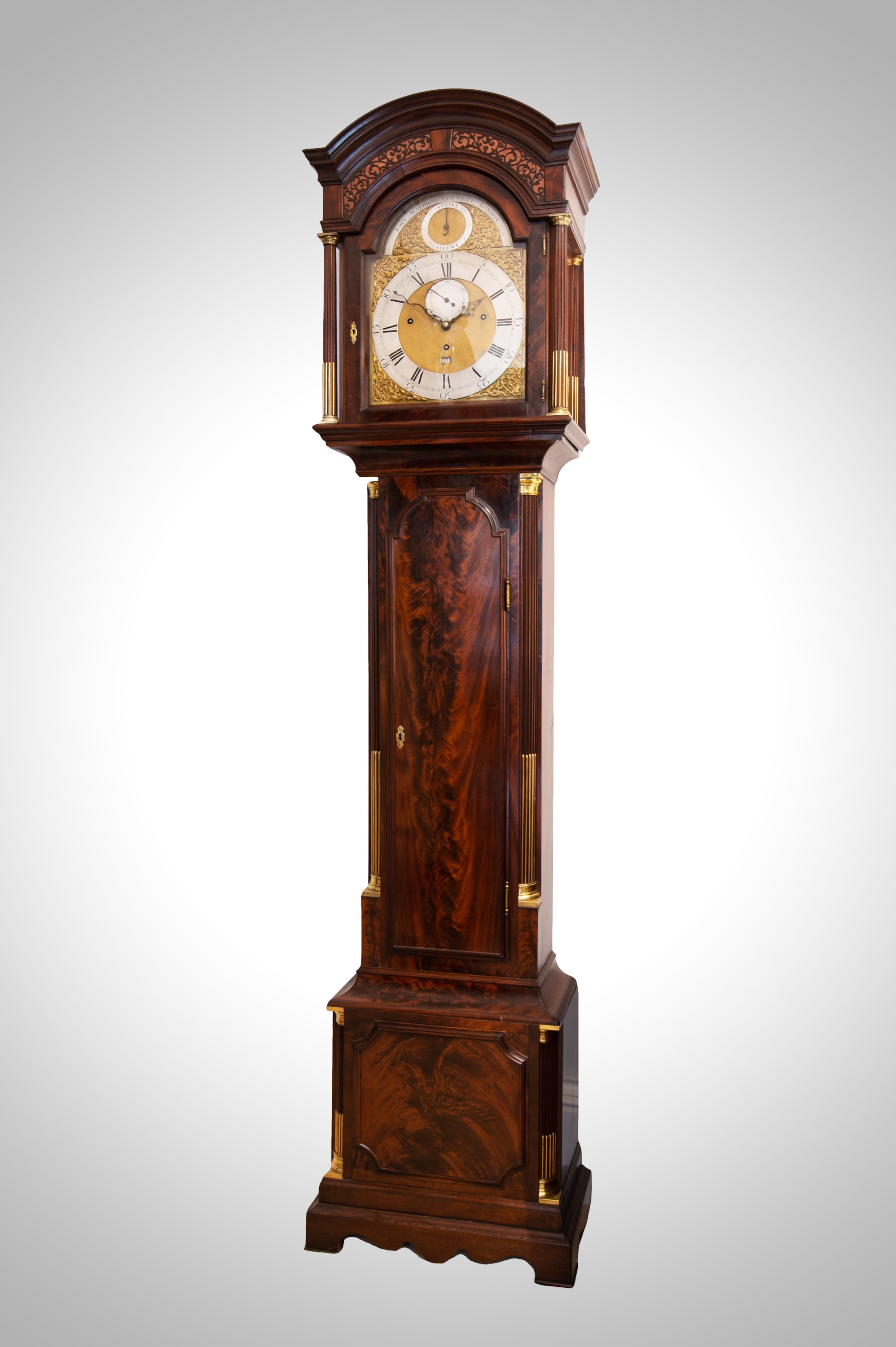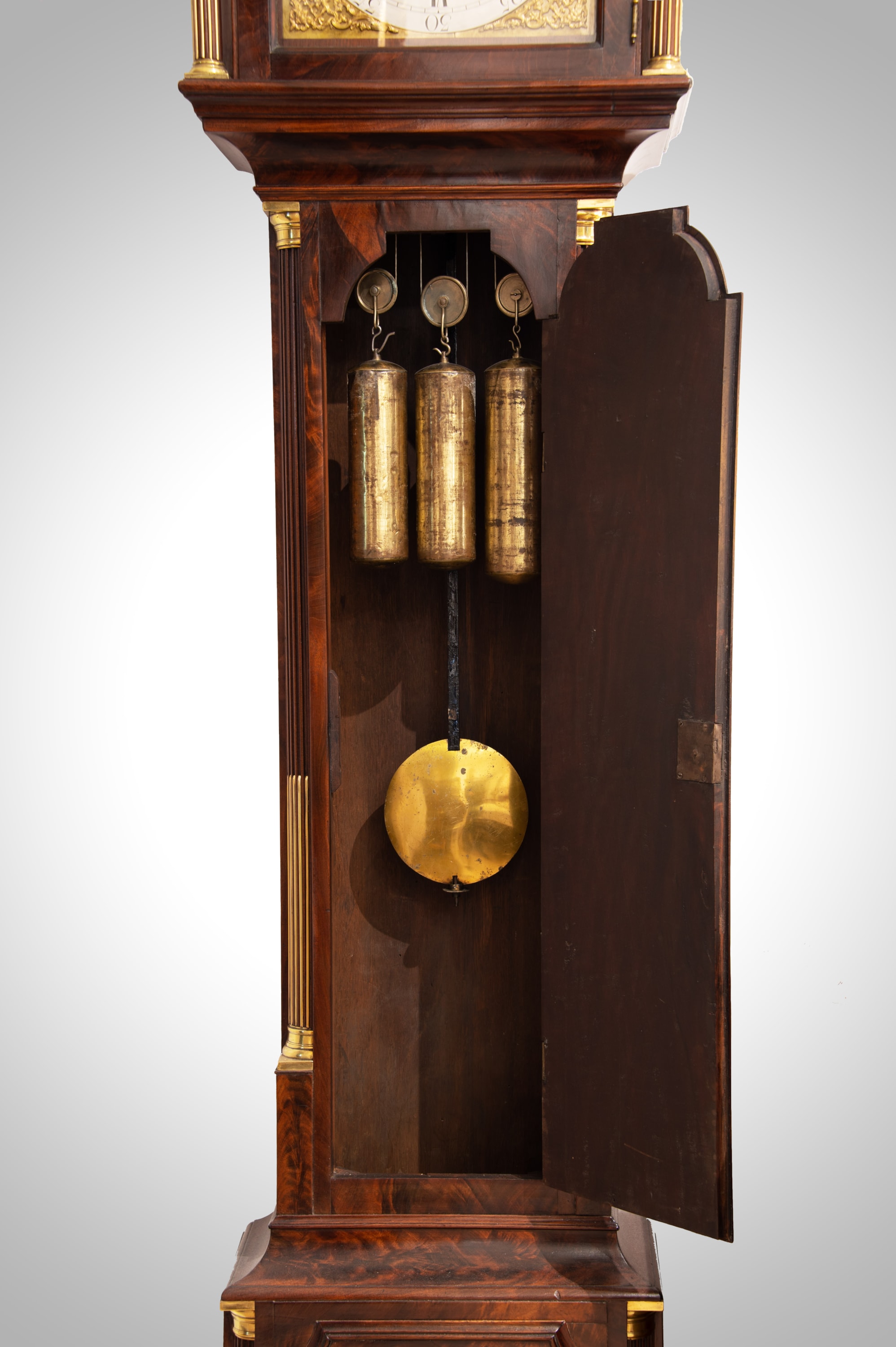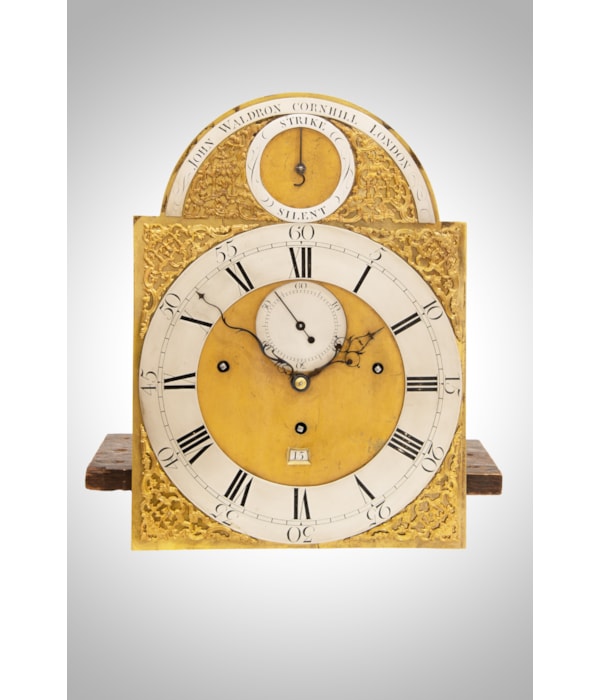Georgian Style & the “London Mahogany”: A Longcase Clock by John Waldron of Cornhill
June 5th 2024
By the middle of the 18th century, Britain has witnessed something of a retail revolution. The merchant classes and aristocracy has taken up shopping as a pastime. Britain had truly become a nation of shopkeepers, with tradesman selling everything from haberdashery to silver, from prints and books to furniture and china. Some of this went part and parcel with the growth in international trade, but also was connected with the construction of new homes and brick terraces in every major city, as the British population had expanded. These new homes needed furniture, carpets, china and artworks to furnish and decorate their interiors.
One area where the British already excelled was the creation of clocks, watches and scientific instruments, including barometers. These too became an essential element in the expansion of both shopping and the growth in domesticity. They complemented the furniture being designed and created at this time by the likes of Chippendale, Robert Adam and others. The longcase, or “grandfather” clock soon became a standard feature on the Georgian interior, as quintessential as fine mahogany dining tables, the armchair or pier table. It should not be surprising then that during the reign of George III there was a huge output of high-quality longcase clocks made to integrate with both Georgian architectural interiors and to meet the desires of the growing merchant and middle classes seeking to keep up with aristocratic fashions. They were often made of mahogany, a wood which became de-rigueur from the middle of the century – the horology historian Brian Loomes referred to these clocks as the “London Mahogany” clock, based on their consistency of style and quality.


This superb George III longcase clock by John Waldron of London, dating to about 1765, is a fine example of this. It is veneered throughout with patinated figured mahogany of excellent colour. The base, trunk with opening door and arched top hood all have brass capped columns with fluting and further brass rodding – these embellishments show a direct connection with the classical architecture and interiors that were then in fashion.

The substantial six-pillar 3-train movement strikes each quarter hour on a single small bell and each hour on passing on a further larger bell. The brass dial has a strike/silent selector in the arch which also bears the maker’s signature, John Waldron, Cornhill, London. The main dial beneath show the seconds and the date and also has delicate pierced blued-steel hands. There are three matching brass covered weights and substantial pendulum with large brass lens bob, all very probably original to the clock.

John Waldron is recorded as having worked in the Cornhill district of the City of London, which had long been a hub for clockmakers. He had first been apprenticed to Joseph Dudds, before setting up his own business making clocks and watches. He died in 1770, so this clock is perhaps an example of his key years as a master craftsmen and clockmaker. His will survives in the National Archives at Kew – he left a number of bequests, so it would appear his business was successful. Interestingly, Waldron is known to have made repairs to a watch for General George Washington in 1766!
One area where the British already excelled was the creation of clocks, watches and scientific instruments, including barometers. These too became an essential element in the expansion of both shopping and the growth in domesticity. They complemented the furniture being designed and created at this time by the likes of Chippendale, Robert Adam and others. The longcase, or “grandfather” clock soon became a standard feature on the Georgian interior, as quintessential as fine mahogany dining tables, the armchair or pier table. It should not be surprising then that during the reign of George III there was a huge output of high-quality longcase clocks made to integrate with both Georgian architectural interiors and to meet the desires of the growing merchant and middle classes seeking to keep up with aristocratic fashions. They were often made of mahogany, a wood which became de-rigueur from the middle of the century – the horology historian Brian Loomes referred to these clocks as the “London Mahogany” clock, based on their consistency of style and quality.

This superb George III longcase clock by John Waldron of London, dating to about 1765, is a fine example of this. It is veneered throughout with patinated figured mahogany of excellent colour. The base, trunk with opening door and arched top hood all have brass capped columns with fluting and further brass rodding – these embellishments show a direct connection with the classical architecture and interiors that were then in fashion.

The substantial six-pillar 3-train movement strikes each quarter hour on a single small bell and each hour on passing on a further larger bell. The brass dial has a strike/silent selector in the arch which also bears the maker’s signature, John Waldron, Cornhill, London. The main dial beneath show the seconds and the date and also has delicate pierced blued-steel hands. There are three matching brass covered weights and substantial pendulum with large brass lens bob, all very probably original to the clock.

John Waldron is recorded as having worked in the Cornhill district of the City of London, which had long been a hub for clockmakers. He had first been apprenticed to Joseph Dudds, before setting up his own business making clocks and watches. He died in 1770, so this clock is perhaps an example of his key years as a master craftsmen and clockmaker. His will survives in the National Archives at Kew – he left a number of bequests, so it would appear his business was successful. Interestingly, Waldron is known to have made repairs to a watch for General George Washington in 1766!

